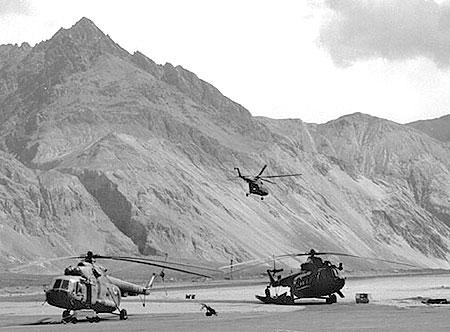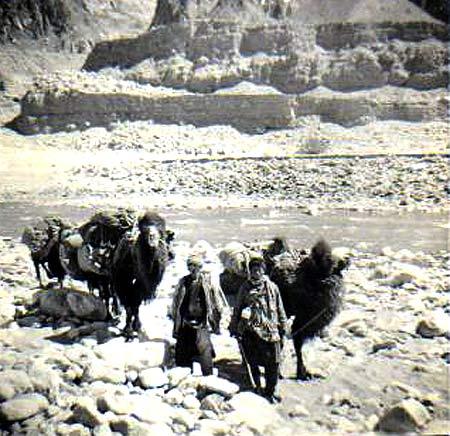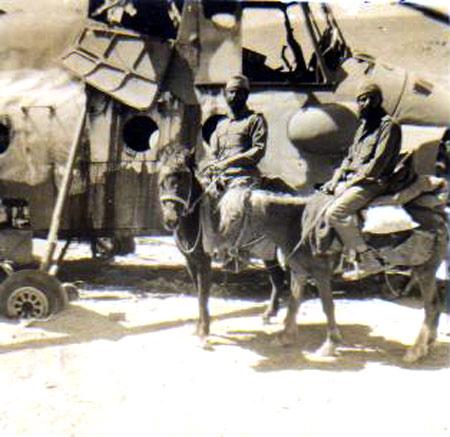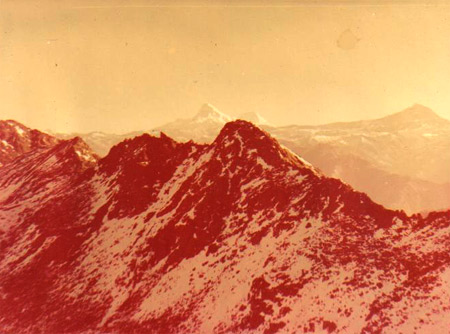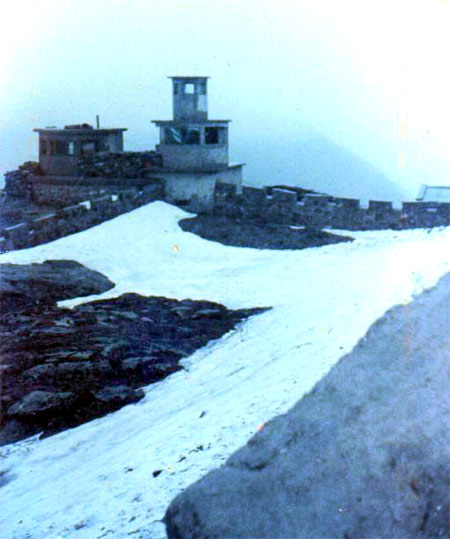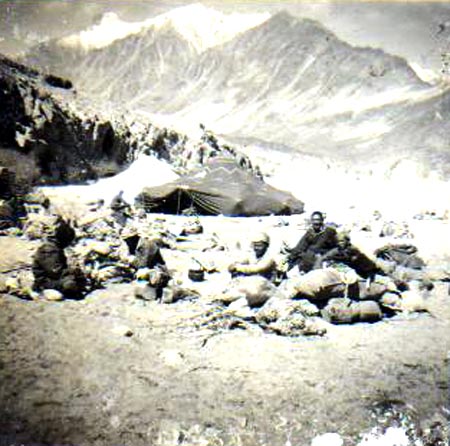
The Rediff Special/Claude Arpi 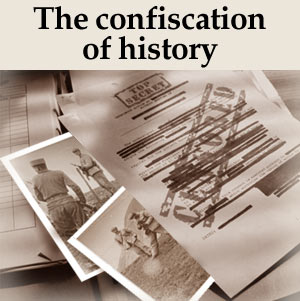  If someone asked me what is the greatest scam since Independence, I would have some difficulty answering. I might initially consider the 'Jeep case' involving Krishna Menon, or the smoking guns of Bofors. But in the end, the one that I find the most stupid, and perhaps the most harmful to India's interests in the long run, is the confiscation of history by government babus under the Public Records Act. These rules vaguely state that "unclassified public records more than 30 years old should be made available to any bona fide research scholar, but subject to such exceptions and restrictions as may be prescribed". Because of the last part of the sentence, the people of India are today not able to know about their recent history. One of the main casualties is the 1962 war with China. As a sad result of this policy, the Chinese version of history is often prevalent, even in India. A few weeks after the debacle of October-November 1962, Lieutenant General J N Chaudhuri constituted a committee to study the causes of the 'Himalayan blunder'. An Anglo-Indian general called Henderson Brooks was requested to go through the official records and prepare a report on the war. Sometime in 1963, the general presented his study to Nehru and a couple of his ministers. The report was immediately classified 'Top Secret'. One can understand that at that time the prime minister did not want the report made to be public, as he may have had to take responsibility for the unpreparedness of the army and, most probably, resign. The tragedy is not that the report was 'classified' in 1963, but that it continues to remain classified today. Forty years later, nobody has still seen the report. That is, except for one person: a British foreign correspondent named Neville Maxwell. The rumour is that a senior minister passed on the report to him. Nine years after the war, when Henry Kissinger made a secret trip to Beijing to prepare President Nixon's visit to China in February 1972, he stayed five days in China and had a series of 10 crucial meetings with Zhou Enlai, the Chinese premier. The transcripts of these talks, which were recently 'declassified' by the US administration, are mind-opening, particularly in the above context. Here are some of Kissinger's remarks to Zhou Enlai: "I read the book by Maxwell that the prime minister recommended to me last time, and it is our view, certainly at the White House, that the Indians are applying the same tactics to that situation as they did to you."  Kissinger refers to
Maxwell's book India's China War, which shows India as an aggressive
nation that bullied China during the 1962 war. Later in the discussion, the
Chinese premier comes back to Maxwell's book: "We [the Chinese]
understand best the traditions of India. After having read the book of Maxwell
you also believe it [that bullying others] is the traditional policy of India." Kissinger refers to
Maxwell's book India's China War, which shows India as an aggressive
nation that bullied China during the 1962 war. Later in the discussion, the
Chinese premier comes back to Maxwell's book: "We [the Chinese]
understand best the traditions of India. After having read the book of Maxwell
you also believe it [that bullying others] is the traditional policy of India."
It is amazing that Maxwell, thanks to the Government of India's propensity for secrecy, is the only person who has managed to see the Henderson Brooks report. Maxwell stated himself in the Economic & Political Weekly in 2001: "The report includes no surprises and its publication would be of little significance, but for the fact that so many in India still cling to the soothing fantasy of a 1962 Chinese 'aggression'." Yes, the theory put forward by the Chinese and Maxwell is that the war was only due to Nehru's aggressive policy and China had no other choice but to launch a 'pre-emptive attack' on October 20 on the slopes of Tagla ridge. Not only did India lose the Aksai Chin and other territories in Kashmir in the 1950s, but India became the bully, the 'expansionist' nation. One can only be sad that 40 years after the event, the Government of India is still adding water to the Chinese half-baked history mill by continuing to hide what is most probably a quite insignificant report. The burial of the Henderson Brooks report, however, raises several other questions. When one reads Indian newspapers, one gets the impression that the people of India (or at least the journalists of India) are greatly interested in history. For the past few years, not a day has passed without one comment or another on the history textbooks that have been revised by the NCERT; or the HRD minister who is supposedly spending his time 'rewriting' Indian history, or adding colour to historical facts. But tell me, what is wrong in 'rewriting' history books when it is necessary? The great son of India, Gautama Buddha, once told his disciples: 'As the wise test gold by burning, cutting and rubbing it on a piece of touchstone, so are you to accept my words only after examining them and not merely out of regard for me." As long as there is new information, new inputs or documents, history needs to be researched and researched again, in the Buddha's fashion. Is it not in the interest of a nation to know her past? The great misfortune in the case of the 1962 war is that there is no will from the government's side to give the means to those inclined to do this research to obtain a truer picture of the past.  Personally, I faced a
similar problem when I tried to research my two pet subjects: Tibet and Kashmir.
Going through the painful exercise of trying to access some documents at the
time of the Chinese invasion of Tibet (1950) was a nightmare. Personally, I faced a
similar problem when I tried to research my two pet subjects: Tibet and Kashmir.
Going through the painful exercise of trying to access some documents at the
time of the Chinese invasion of Tibet (1950) was a nightmare.
At the National Archives of India, I was told that all documents for the NEFA area (which included Tibet and Bhutan) were 'classified' after 1913 and nobody could access them. For 'Gilgit area' [read Kashmir], the date is 1923. This colonial terminology gives an indication of the backwardness of the historical studies in India. Have not the British left India 55 years ago? What about the famous 'Nehru's Papers'? They are kept in the Nehru Library by a private trust, chaired by the leader of the opposition, and you have to obtain her consent to see them. In any case, you cannot see them, as they are 'restricted'. Only 'official' historians are able to study them. The very helpful staff can only tell you: "Sorry, sir, this is the rule." India must be the only nation where the prime minister's official papers belong to his family and not the state! In my case it was even more stupid because most of the political files regarding Tibet from 1914 till as late as 1952-53 were freely available for researchers in the India Office Library and Records in London. The moral of the story: go to London to study Indian history. Different reasons are given as to why historical documents should not be 'declassified'. The most current and irrelevant argument is that these old documents are of a 'sensitive' nature and their circulation may jeopardize India's security. I believe that some years ago, a 'group of secretaries', the most dreaded order of the babu species, stopped the publication of the report of the 1965 war because: "it gave information about certain aspects of command and control." Luckily, a Good Samaritan managed to get hold of a copy and post it on an Internet site.  But something is
even more incongruous. While the Government of India is holding the Henderson
Brooks report close to its chest, a very historic international conference was
held in Cuba recently. But something is
even more incongruous. While the Government of India is holding the Henderson
Brooks report close to its chest, a very historic international conference was
held in Cuba recently.
Many will remember that the week the Chinese troops entered in the Northeast and in Ladakh, humanity was coming very close to its first nuclear war. This was the Cold War's climax: the confrontation between the United States and the Soviet Union in Cuba over the installation of ballistic missiles targeting American cities threatened to degenerate into World War III. To commemorate the stupendous events of the Bay of Pigs, the Cuban government, with the National Security Archive of George Washington University, organized a conference titled "The October Crisis: Political Perspectives 40 Years Later". Some of the veterans who participated in those historic days were invited to discuss the conflict between Khrushchev and Kennedy. During the last session of the conference, the participants, including Cuban president Fidel Castro and former US secretary of defence Robert McNamara discussed some newly declassified documents. The documents show that the Soviet nuclear-armed tactical weapons in Cuba stayed there after the missiles were withdrawn, and may even have been intended for Cuban custody. "Documents released today included verbatim Soviet records of the contentious meetings between top Soviet leader Anastas Mikoyan and top Cuban leaders, including Fidel Castro and Che Guevara, during Mikoyan's trip to Cuba in early November; Soviet orders first preparing the tactical weapons for training the Cubans and then, on November 20, ordering their withdrawal; and a prophetic summary of the crisis written by the British ambassador to Cuba, who predicted that the crisis could ultimately rebound to the benefit of the Castro regime and the long-term survival of Communism in Cuba," said a press release. Some may think that Cuba is a totalitarian banana republic, but Fidel Castro did organise the conference and participate in it. We cannot dream of such a debate in India today. Why? I have no answer. We have in Delhi many universities, policy centres, think-tanks, a host of retired 'thinking' generals (as if the serving generals are not able to think). Why can't any of them take up the challenge and open a debate on what really happened in 1962? Many fields of research have remained untouched. To give a few examples:
(Claude Arpi, author of The Fate Of Tibet (HarAnand), which has also been translated into French, writes regularly for rediff.com) |
source:rediff.com

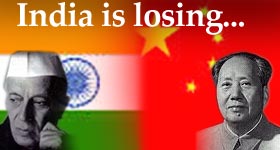 "We are
getting out of touch with realities in a modern world; we are living in our own
creation and we have been shaken out of it."
These words spoken by Nehru in 1962 expressed his shock and disbelief at the
Chinese invasion of India's northeastern border. Yet, on the 40th anniversary of
the border clash, these words seem more prophetic than descriptive.
"We are
getting out of touch with realities in a modern world; we are living in our own
creation and we have been shaken out of it."
These words spoken by Nehru in 1962 expressed his shock and disbelief at the
Chinese invasion of India's northeastern border. Yet, on the 40th anniversary of
the border clash, these words seem more prophetic than descriptive. 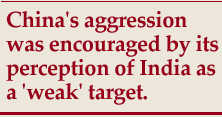 China's aggression was encouraged by its perception of India as a "weak" target.
After all, Nehru had taken no action in 1951 when China invaded and occupied
Tibet, eliminating the traditional buffer between the two; and, except to grant
asylum to the Dalai Lama, he, again, did nothing in 1959, when China ruthlessly
put down the uprising in Tibet.
China's aggression was encouraged by its perception of India as a "weak" target.
After all, Nehru had taken no action in 1951 when China invaded and occupied
Tibet, eliminating the traditional buffer between the two; and, except to grant
asylum to the Dalai Lama, he, again, did nothing in 1959, when China ruthlessly
put down the uprising in Tibet.
 China
has also encroached on India's traditional spheres of influence in Nepal,
Bhutan, and Burma, by establishing trade and military relations; and China has
increased its presence in the Indian Ocean with bases in Burma and Pakistan,
challenging India in its own backyard.
China
has also encroached on India's traditional spheres of influence in Nepal,
Bhutan, and Burma, by establishing trade and military relations; and China has
increased its presence in the Indian Ocean with bases in Burma and Pakistan,
challenging India in its own backyard.
 It
cannot find a way to either put off or come to terms with Pakistan. It has been
unable to make a significant shift away from its socialist economy, despite
various attempts since 1991. And even in the case of its border dispute with
China, which has offered to exchange territory to settle the issue, India
remains frozen in time, unable to accept anything that does not redeem its
honour.
It
cannot find a way to either put off or come to terms with Pakistan. It has been
unable to make a significant shift away from its socialist economy, despite
various attempts since 1991. And even in the case of its border dispute with
China, which has offered to exchange territory to settle the issue, India
remains frozen in time, unable to accept anything that does not redeem its
honour.










